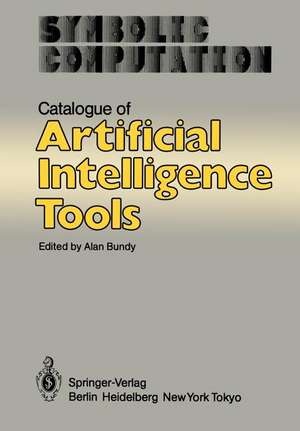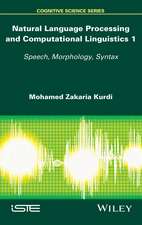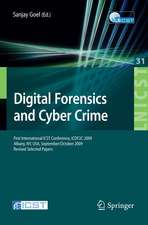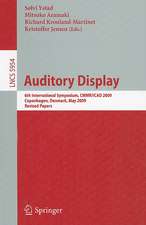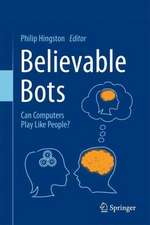Catalogue of Artificial Intelligence Tools: Symbolic Computation
Lincoln Wallen Editat de A. Bundyen Limba Engleză Paperback – noi 1984
Din seria Symbolic Computation
- 20%
 Preț: 350.21 lei
Preț: 350.21 lei - 20%
 Preț: 651.89 lei
Preț: 651.89 lei - 20%
 Preț: 647.61 lei
Preț: 647.61 lei - 20%
 Preț: 649.09 lei
Preț: 649.09 lei - 20%
 Preț: 648.44 lei
Preț: 648.44 lei - 20%
 Preț: 639.35 lei
Preț: 639.35 lei - 20%
 Preț: 653.06 lei
Preț: 653.06 lei - 20%
 Preț: 642.19 lei
Preț: 642.19 lei - 20%
 Preț: 651.09 lei
Preț: 651.09 lei - 20%
 Preț: 659.97 lei
Preț: 659.97 lei - 20%
 Preț: 645.31 lei
Preț: 645.31 lei - 20%
 Preț: 648.44 lei
Preț: 648.44 lei - 20%
 Preț: 650.27 lei
Preț: 650.27 lei - 20%
 Preț: 646.47 lei
Preț: 646.47 lei -
 Preț: 394.29 lei
Preț: 394.29 lei - 20%
 Preț: 326.46 lei
Preț: 326.46 lei - 20%
 Preț: 342.28 lei
Preț: 342.28 lei - 20%
 Preț: 339.99 lei
Preț: 339.99 lei - 20%
 Preț: 657.99 lei
Preț: 657.99 lei - 20%
 Preț: 648.26 lei
Preț: 648.26 lei - 20%
 Preț: 661.47 lei
Preț: 661.47 lei - 15%
 Preț: 638.89 lei
Preț: 638.89 lei - 20%
 Preț: 657.67 lei
Preț: 657.67 lei - 20%
 Preț: 652.73 lei
Preț: 652.73 lei - 20%
 Preț: 330.42 lei
Preț: 330.42 lei - 20%
 Preț: 709.98 lei
Preț: 709.98 lei - 20%
 Preț: 834.69 lei
Preț: 834.69 lei - 20%
 Preț: 656.03 lei
Preț: 656.03 lei - 20%
 Preț: 324.64 lei
Preț: 324.64 lei - 20%
 Preț: 757.48 lei
Preț: 757.48 lei - 20%
 Preț: 355.67 lei
Preț: 355.67 lei - 20%
 Preț: 328.27 lei
Preț: 328.27 lei - 20%
 Preț: 330.24 lei
Preț: 330.24 lei - 20%
 Preț: 342.96 lei
Preț: 342.96 lei - 20%
 Preț: 555.53 lei
Preț: 555.53 lei
Preț: 641.01 lei
Preț vechi: 801.27 lei
-20% Nou
Puncte Express: 962
Preț estimativ în valută:
122.65€ • 128.06$ • 101.51£
122.65€ • 128.06$ • 101.51£
Carte tipărită la comandă
Livrare economică 04-18 aprilie
Preluare comenzi: 021 569.72.76
Specificații
ISBN-13: 9783540139386
ISBN-10: 3540139389
Pagini: 180
Ilustrații: XXV, 150 p.
Dimensiuni: 170 x 244 x 10 mm
Greutate: 0.3 kg
Ediția:Softcover reprint of the original 1st ed. 1984
Editura: Springer Berlin, Heidelberg
Colecția Springer
Seriile Symbolic Computation, Artificial Intelligence
Locul publicării:Berlin, Heidelberg, Germany
ISBN-10: 3540139389
Pagini: 180
Ilustrații: XXV, 150 p.
Dimensiuni: 170 x 244 x 10 mm
Greutate: 0.3 kg
Ediția:Softcover reprint of the original 1st ed. 1984
Editura: Springer Berlin, Heidelberg
Colecția Springer
Seriile Symbolic Computation, Artificial Intelligence
Locul publicării:Berlin, Heidelberg, Germany
Public țintă
ResearchCuprins
1. 2 1/2-D Sketch.- 2. A* Algorithm.- 3. ACLS: Analogue Concept Learning System.- 4. Actors.- 5. AGE.- 6. ALICE.- 7. Alpha/Beta Pruning.- 8. AL/X.- 9. AMORD.- 10. Analogical Problem Solving.- 11. APES.- 12. ARBY.- 13. Associative Database.- 14. Augmented Transition Network.- 15. B* Algorithm.- 16. Bandpass Filter.- 17. Bayesian Inference.- 18. Bidirectional Search.- 19. Blackboard.- 20. Bottom-Up Parsing.- 21. Boundary Detection.- 22. Boyer-Moore Theorem Prover.- 23. Branch-and-Bound Algorithms.- 24. Breadth-First Parsing.- 25. Breadth-First Search.- 26. Cambridge LISP.- 27. Cascaded Augmented Transition Network.- 28. Case Frames.- 29. Cellular Arrays.- 30. Chart Parsing.- 31. CHI.- 32. Classification.- 33. Clausal Form.- 34. Common LISP.- 35. Computer Audiometry.- 36. Conceptual Dependency.- 37. Connection Machine.- 38. CONNIVER.- 39. Constraint Satisfaction and Propagation.- 40. Constructive Solid Geometry.- 41. Context-Free Grammar.- 42. Contour Generator.- 43. Contradiction Backtracing.- 44. Contrast Sensitivity Function.- 45. Convolution.- 46. DADO.- 47. Data-Directed Control.- 48. Default Reasoning.- 49. Definite Clause Grammars.- 50. Delayed Evaluation.- 51. Demon.- 52. Dempster-Shafer Theory.- 53. Dependency Directed Backtracking.- 54. Depth-First Parsing.- 55. Depth-First Search.- 56. Deterministic Parsing.- 57. Difference of Gaussians.- 58. Discrimination Learning.- 59. Discrimination Net.- 60. Distance Transform.- 61. Distributed Problem Solving.- 62. Dynamic Programming.- 63. Dynamic Time Warping.- 64. Earleys Algorithm.- 65. Edge Detection.- 66. EMYCIN.- 67. Envisioning.- 68. Expert.- 69. Fast Pattern Recognition Techniques.- 70. Finding Common Paths.- 71. Flynn Classification.- 72. Focussing.- 73. Formant.- 74. Formant Synthesis.- 75. FORTRAN.- 76. Forward/Bacward Search.- 77. Frame.- 78. FRL.- 79. Functional Data Model.- 80. Functional Grammar.- 81. Fuzzy Relational Products.- 82. Fuzzy Set Theory.- 83. Generalised Cylinders.- 84. Generalised Hough Transform.- 85. Generative Capacity.- 86. Goal Structure.- 87. Golay Neighbourhoods.- 88. Gradient Space.- 89. Grey-Level Image.- 90. Heterarchy.- 91. Hearsay-III.- 92. Heuristic Search.- 93. Hierarchical Planning.- 94. High-Emphasis Filtering.- 95. Hook.- 96. Hope.- 97. Horn Clauses.- 98. Image Data Structures.- 99. Image Segmentation.- 100. Inference Engine Toolkit.- 101. Inferno.- 102. Interactions Between Sub-Goals.- 103. Interlisp-D.- 104. Intern Demons.- 105. Intrinsic Images.- 106. Invariant Queues.- 107. Invariant Violation Demons.- 108. ISA Hierarchy.- 109. Island Parsing.- 110. Junction Dictionary.- 111. KAS: Knowleoge Acquisition System.- 112. Kinematics.- 113. KL-ONE/KL-TWO.- 114. KRC.- 115. KRL.- 116. Laplacian.- 117. LCF.- 118. Learning from Solution Paths.- 119. Lexical Access.- 120. LIFER.- 121. Line Finding.- 122. Line Labelling.- 123. Linear Predictive Coding.- 124. Lispkit.- 125. LM.- 126. LM-GEO.- 127. Local Grey-Level Operations.- 128. Logic Machine Architecture.- 129. LOGLISP.- 130. LOGO.- 131. LOOPS.- 132. MACLISP.- 133. Macro Operators.- 134. MACSYMA.- 135. Markgraf Karl Refutation Procedure.- 136. MBASE.- 137. MDL.- 138. Means/Ends Analysis.- 139. Meta-Level Inference.- 140. Meta-Planning.- 141. Meta-Rules.- 142. Micro Expert.- 143. Micro-PLANNER.- 144. Micro-PROLOG.- 145. Minimax.- 146. ML.- 147. Model Directed Search.- 148. Modulation Transfer Function.- 149. Morphographemics.- 150. MProlog.- 151. Multi-Actor System.- 152. Multi-Pulse LPC.- 153. Natural Deduction.- 154. Negation as Failure.- 155. Neighbourhood Parallelism.- 156. NIAL (Nested Interactive Array Language).- 157. NIL.- 158. Non-Linear Planning.- 159. Non-Monotonic Reasoning.- 160. Numerically-Controlled Machine Tools.- 161. Object-Centred Co-Ordinates.- 162. One-Then-Best Backtracking.- 163. Operator Table.- 164. Operators.- 165. Opportunistic Search.- 166. OPS5.- 167. Optical Flow.- 168. Optimistic Plan Execution.- 169. Overloaded Operators.- 170. Paramodulation.- 171. Partial Evaluation.- 172. Partitioned Semantic Net.- 173. Pattern Directed Retrieval/Invocation.- 174. Pattern Matching.- 175. Perceptrons.- 176. Photometric Stereo.- 177. Pipelining.- 178. Pitch Extraction.- 179. Plan Recognition.- 180. Plan Structure.- 181. POP-2.- 182. POP-11.- 183. POPLOG.- 184. Portable Standard LISP.- 185. Postulating Intrinsic Properties.- 186. Precondition Analysis.- 187. Predictive Parsing.- 188. Procedural Attachment.- 189. Predicate Calculus.- 190. Preference Semantics.- 191. Primal Sketch.- 192. Production Rule System.- 193. Program Synthesis.- 194. Program Transformation.- 195. Programming Cliche.- 196. PROLOG.- 197. Propagation in Cellular Arrays.- 198. Property Lists.- 199. Propositional Constraint Propagation.- 200. Protocol Analysis.- 201. PSI.- 202. Pyramids/Resolution Cones.- 203. QLISP/QA4.- 204. Quad Trees.- 205. RAPT.- 206. Reflectance Map.- 207. Refutation Proof.- 208. Region Finding.- 209. Relational Database Query Formulation.- 210. Relaxation Labelling.- 211. Remote Procedure Calls.- 212. Resolution.- 213. Rewrite Rules.- 214. RLL.- 215. ROBMOD.- 216. Robot Dynamics.- 217. Robot Programming.- 218. ROSIE.- 219. RUP.- 220. SAGE.- 221. SAIL.- 222. SASL.- 223. SCRIPT.- 224. Semantic Binary Relationship Model.- 225. Semantic Checking.- 226. Semantic Grammar.- 227. Semantic Net.- 228. Semantic Primitives.- 229. Sensory Feedback and Compliance.- 230.Shape Analysis.- 231. Shape From Shading.- 232. Shape from Texture.- 233. Situation Calculus.- 234. Skeletonisation.- 235. Skolemization.- 236. SmallTalk.- 237. Spatial Differentiation.- 238. Spatial Frequency Channels.- 239. Spelling Correction.- 240. State Space.- 241. Stereopsis.- 242. Structured Induction.- 243. Subgoaling.- 244. SYNICS.- 245. Table of Multiple Effects.- 246. Template Matching.- 247. Time Complexity of Recognition.- 248. Top-Down Parsing.- 249. T-PROLOG.- 250. Truth Maintenance System.- 251. Typed Preconditions.- 252. Unification.- 253. Units.- 254. The UT Theorem Prover.- 255. Variable-Valued Logic.- 256. Version Space.- 257. Viewer-centred Co-ordinates.- 258. Vocoder Representation.- 259. VOLE.- 260. Vowel Quadrilateral.- 261. Zero-Crossings.- 262. ZETALISP.- 263. ZMOB.- 264. ZOG.- Index of Definitions.
